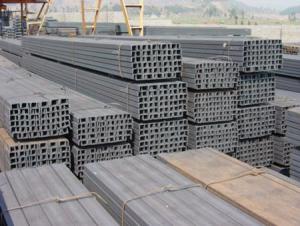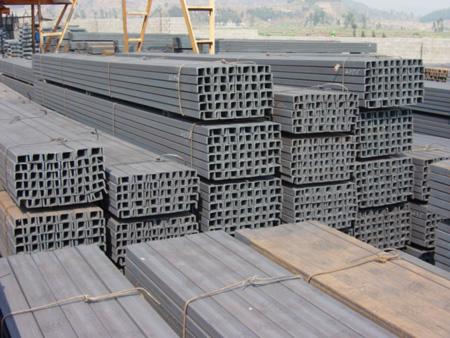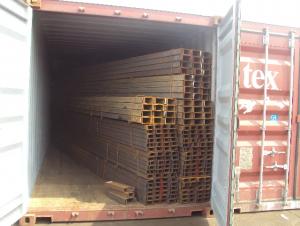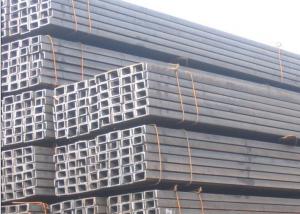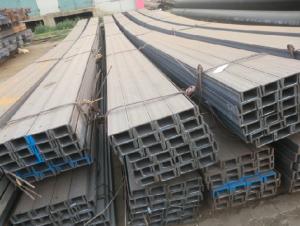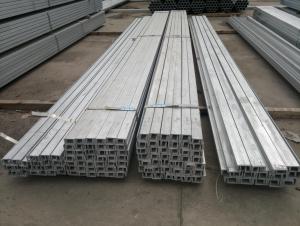GB Channel Steel
- Loading Port:
- China Main Port
- Payment Terms:
- TT OR LC
- Min Order Qty:
- -
- Supply Capability:
- -
OKorder Service Pledge
OKorder Financial Service
You Might Also Like
Specifications of Hot Rolled Channel Steel:
1. We are definitely specializing in manufacturing and supplying channel steel.
| Standard: | GB |
| Material/Grade: | Q235 |
| Sizes: | 50mm to 280mm |
| Sales Volume/Year: | 3000MT |
| Destination Area: | Middle East, Africa, Southeast Asia |
2.Size, Length and Mass.
| Size(mm) | Length(m) | Mass(Kg/m) |
140*58*6.0*9.5 mm | 6m, 12m | 14.535 kg/m |
| 140*60*8.0*9.5 mm | 6m, 12m | 16.733 kg/m |
Package & Delivery of Channel Steel:
The steel u channel will be packed in bundle with steel wire at each end of every bundle and color marking in order to help the customer to recognize his goods more easily at sight.
And steel u channel could be loaded into 20ft or 40ft container, or by bulk cargo. If the weight of each bundle reaches less than 3.5 mt, the loading by break bulk cargo should be choosed. When the weight of each bundle reaches less than 3mt, the loading by container should be choosed.
As for the transportaion from mill to loading port, the truck will be usually used. And the maximum quantity for each truck is 40mt.
All in all, we could do in accordance with customer's request.
If you would like to get our price, please inform us the standard/material, size and quantity. Thank you very much.
- Q: What are the guidelines for steel channel spacing in structural applications?
- The guidelines for steel channel spacing in structural applications vary depending on specific requirements and codes set by local building authorities and engineering standards. However, there are some general guidelines that can be followed. 1. Code Compliance: First and foremost, it is important to comply with applicable building codes and regulations in your area. These codes often specify the minimum requirements for steel channel spacing based on the intended use and structural design. 2. Manufacturer's Recommendations: It is essential to refer to the manufacturer's guidelines and recommendations for the specific steel channel being used. Manufacturers typically provide detailed information on the maximum spacing allowed between channels to maintain structural integrity and load-bearing capacity. 3. Structural Analysis: A qualified engineer must conduct a thorough structural analysis to determine the appropriate spacing between steel channels. This analysis takes into account the loads and forces acting on the structure, as well as the specific design and configuration of the channels. 4. Span-to-Depth Ratio: The spacing between steel channels is influenced by the span-to-depth ratio. This ratio is calculated by dividing the distance between supports (span) by the depth of the channel. Higher span-to-depth ratios may require closer spacing to prevent excessive deflection and ensure structural stability. 5. Load Distribution: Steel channel spacing should also consider the intended load distribution. Channels spaced too far apart can result in uneven load distribution, leading to localized stress concentrations and potential failure. Proper spacing ensures a more uniform load distribution, enhancing the overall strength and stability of the structure. 6. Deflection Limits: Deflection limits, which refer to the bending or deformation of steel channels under load, should be considered when determining channel spacing. Building codes or engineering standards often set these limits. Closer spacing can help reduce deflection and ensure the structure performs as intended. It is crucial to consult with a professional structural engineer or follow the guidance of a licensed design professional to determine the appropriate spacing for steel channels in any structural application.
- Q: How do steel channels contribute to energy conservation?
- There are several ways in which steel channels contribute to energy conservation: 1. Insulation: By using steel channels as structural elements in buildings, heat transfer between the interior and exterior is minimized, resulting in insulation. This insulation helps maintain a comfortable temperature inside the building, reducing the need for excessive heating or cooling and ultimately saving energy. 2. Durability: Steel channels possess a high level of durability and can withstand harsh environmental conditions like extreme temperatures, humidity, and corrosion. This longevity means that structures constructed with steel channels require fewer repairs or replacements, avoiding the energy-intensive process of reconstruction and conserving energy. 3. Energy-efficient manufacturing: Steel channels are often manufactured using recycled steel, which demands less energy compared to producing new steel from scratch. Furthermore, advancements in steel manufacturing processes have made them more energy-efficient, thus reducing the overall carbon footprint. 4. High strength-to-weight ratio: Steel channels have a remarkable strength-to-weight ratio, enabling them to support heavy loads while remaining relatively lightweight. This characteristic allows for the construction of lighter structures, requiring fewer materials and reducing energy consumption during transportation and construction. 5. Versatility and adaptability: Steel channels can be easily modified and repurposed, making it possible to adapt existing structures instead of constructing new ones. This flexibility not only reduces the energy required for new construction and demolition but also minimizes waste generation. All in all, steel channels make significant contributions to energy conservation through their insulation properties, durability, energy-efficient manufacturing, high strength-to-weight ratio, and versatility. By incorporating steel channels into various applications, we can decrease energy consumption, minimize waste, and create more sustainable structures.
- Q: What are the guidelines for steel channel installations in seismic zones?
- To ensure the structural integrity and safety of buildings during seismic events, it is crucial to follow guidelines for steel channel installations in seismic zones. These guidelines are developed based on engineering principles, regulatory bodies, and industry standards. 1. Considerations for Design: When designing steel channel installations in seismic zones, it is important to consider seismic forces, building geometry, and structural connections. A qualified structural engineer should be responsible for the design, taking into account project-specific requirements. 2. Material Selection: It is recommended to use high-quality steel channels that meet the specifications outlined in relevant standards such as ASTM A36 or ASTM A572. Before installation, the channels should be inspected for defects. 3. Connection Details: Proper connection details are essential for withstanding seismic forces. Welding or bolting should be done following approved methods and standards. Connections should be designed to resist both vertical and lateral forces, ensuring overall structure stability. 4. Anchorage: Steel channel installations should be securely anchored to the building's foundation or structural system. Design specifications should dictate the use of anchor bolts or other approved anchorage methods capable of withstanding anticipated seismic forces. 5. Seismic Bracing: Additional bracing may be necessary in seismic zones to enhance the stability of steel channel installations. Diagonal braces or moment frames should be designed and installed to resist lateral forces. The bracing layout and connections should comply with relevant codes and standards. 6. Inspection and Quality Control: Qualified personnel should regularly inspect steel channel installations to ensure compliance with design specifications and codes. Quality control measures should be implemented to monitor the manufacturing, fabrication, and installation processes. 7. Compliance with Local Codes: Familiarity with and adherence to specific seismic design codes and regulations in the project's location is essential. Consultation with local building authorities is necessary to meet all applicable requirements. Ultimately, the guidelines for steel channel installations in seismic zones aim to create safe and resilient structures capable of withstanding seismic forces. Engaging the expertise of qualified professionals, such as structural engineers, is crucial to accurately follow the guidelines and meet necessary standards.
- Q: What are the different methods for protecting steel channels from corrosion?
- There are several methods for protecting steel channels from corrosion. One common approach is applying a protective coating, such as paint or powder coating, which creates a barrier between the steel and the environment. Another method is galvanizing, where a layer of zinc is applied to the steel surface through hot-dip or electroplating, providing corrosion resistance. Additionally, using stainless steel channels, which contain a high percentage of chromium, can offer excellent corrosion resistance. Regular maintenance, such as cleaning and removing accumulated debris or moisture, can also help prevent corrosion on steel channels.
- Q: Are steel channels suitable for use in bridges?
- Yes, steel channels are suitable for use in bridges. Steel channels offer several advantages that make them a popular choice for bridge construction. Firstly, steel channels are known for their high strength-to-weight ratio, which allows for the construction of lightweight yet durable bridges. This is particularly important in areas with limitations on the weight that can be supported by the ground or existing infrastructure. Additionally, steel channels provide excellent resistance to corrosion. Bridges are often exposed to harsh environmental conditions, such as rain, snow, and moisture, which can cause deterioration of the materials used. Steel channels are typically made from corrosion-resistant alloys or are coated with protective layers, making them highly durable and ensuring the longevity of the bridge structure. Furthermore, steel channels offer versatility in design and fabrication. They can be easily shaped, cut, and welded to meet specific project requirements, allowing for the creation of intricate bridge designs. Steel channels also provide the flexibility to adapt to different load-bearing capacities, enabling engineers to construct bridges that can accommodate varying traffic volumes and weights. Lastly, steel channels have a long history of successful use in bridge construction. They have been extensively tested and proven to withstand heavy loads, extreme weather conditions, and provide long-term structural integrity. In conclusion, steel channels are a suitable choice for use in bridges due to their high strength-to-weight ratio, resistance to corrosion, versatility in design, and proven track record of performance.
- Q: How do steel channels contribute to the overall recyclability of a building?
- Steel channels play a crucial role in enhancing the overall recyclability of a building. These structural components are widely used in construction due to their durability, strength, and versatility. When it comes to recycling, steel channels offer several benefits that positively impact the sustainability of the building industry. Firstly, steel channels are highly recyclable themselves. Steel is one of the most recycled materials globally, with an excellent recycling rate of around 90%. This means that steel channels can be easily recovered and reused at the end of a building's lifecycle, reducing the need for virgin steel production. Recycling steel channels not only conserves valuable resources but also reduces the energy consumption and greenhouse gas emissions associated with manufacturing new steel. Moreover, steel channels contribute to the overall recyclability of a building by facilitating the disassembly and separation of various building components during the demolition or renovation process. These channels provide structural support and act as frameworks for other materials, such as walls, floors, and ceilings. By using steel channels, builders can create modular designs that allow for easier deconstruction and recycling of different building elements. Additionally, the use of steel channels in construction promotes the concept of adaptive reuse. Adaptive reuse involves repurposing existing buildings for new functions instead of demolishing them. Steel channels, being easily adaptable and reusable, enable the conversion of buildings without substantial structural modifications. This approach minimizes waste generation and lessens the environmental impact associated with constructing entirely new buildings. Furthermore, steel channels have a long lifespan due to their durability, which extends the overall life cycle of a building. By using durable materials like steel, buildings can remain functional for a more extended period, reducing the need for frequent replacements or renovations. This longevity contributes to the sustainability of the building industry by reducing waste generation and conserving resources. In conclusion, steel channels significantly enhance the overall recyclability of a building. Their high recyclability, facilitation of deconstruction, adaptability for adaptive reuse, and durability contribute to reducing waste, conserving resources, and minimizing environmental impact. Incorporating steel channels in construction projects promotes a more sustainable and circular economy in the building industry.
- Q: How many tons per ton for channel 12?
- 12# channel height 120 mm, leg width 53 mm, waist thickness 5.5 mm, 12.06 kg / m, about 13.5 tons per ton, price about 3700 yuan per ton
- Q: What are the different finishing techniques for steel channels?
- There are several different finishing techniques that can be used on steel channels to enhance their appearance and protect them from corrosion. One common finishing technique is galvanizing. This involves coating the steel channels with a thin layer of zinc, which provides excellent corrosion resistance. The zinc coating can be applied through either hot-dip galvanizing, where the channels are immersed in a bath of molten zinc, or through electroplating, where an electric current is used to deposit the zinc onto the surface of the channels. Galvanized steel channels have a distinctive silver-gray appearance. Another finishing technique is powder coating. This involves applying a dry powder to the steel channels and then baking it in an oven to create a durable and decorative finish. Powder coating is available in a wide range of colors and can provide a smooth and even coating on the channels. Painting is another common finishing technique for steel channels. This involves applying a liquid paint to the surface of the channels. The paint can be applied through various methods such as brushing, spraying, or dipping. Painting not only enhances the appearance of the channels but also provides a protective barrier against corrosion. In addition to these techniques, steel channels can also be polished or brushed to create a smooth and shiny surface. Polishing involves using abrasive materials to remove any imperfections and create a reflective surface. Brushing, on the other hand, involves using a wire brush or abrasive pad to create a textured finish on the surface of the channels. Overall, there are several different finishing techniques available for steel channels, each with its own advantages and aesthetic appeal. The choice of finishing technique will depend on factors such as the desired appearance, corrosion resistance requirements, and cost considerations.
- Q: Can steel channels be used for supporting HVAC systems?
- Yes, steel channels can be used for supporting HVAC systems. Steel channels are commonly used for providing structural support and stability, making them suitable for supporting the weight of HVAC equipment and components.
- Q: What's the weight of the 4 meter long 18 channel steel?
- Channel steel is a strip of steel with a cross section. Section steel with groove shape. Channel steel is a kind of carbon structural steel used for construction and machinery. It is a complex section steel. Its cross section has a groove shape. Channel steel is mainly used in building structure, curtain wall engineering, mechanical equipment and vehicle manufacturing, etc.. In use, it requires better welding, riveting performance and comprehensive mechanical properties. The raw material steel billet for channel steel is carbon or low alloy steel billets with a carbon content of not more than 0.25%. The finished channel steel is delivered by hot forming, normalizing or hot rolling. The specifications are expressed in millimeters of height (H) * leg width (b) * waist thickness (d), such as 100*48*5.3, which means waist height is 100 mm, leg width is 48 mm, waist thickness is 5.3 mm channel, or 10# channel steel. The same height of the channel, if there are several different leg width and waist thickness, also need to add a, B, C on the right side of the model to distinguish, such as 25#a, 25#b, 25#c and so on.
Send your message to us
GB Channel Steel
- Loading Port:
- China Main Port
- Payment Terms:
- TT OR LC
- Min Order Qty:
- -
- Supply Capability:
- -
OKorder Service Pledge
OKorder Financial Service
Similar products
Hot products
Hot Searches
Related keywords
